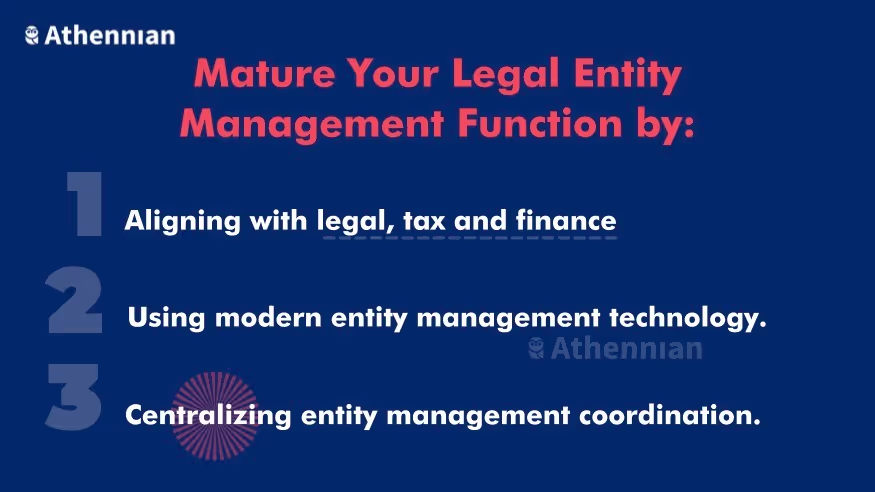In a recent survey by EY, 89% of legal department leaders reported substantial challenges with legal entity management giving them concerns about being deal ready.
There are typically three reasons why the management of legal entities is a cause of concern for legal, finance and tax leaders.
- Entity Management is often a “shared responsibility”
Legal entity management tends to be a “shared responsibility” between legal, tax and finance departments. 76% of legal departments surveyed reported having five or fewer employees focused on entity management. However, 73% reported leveraging finance departments and 53% reported utilizing the tax departments in the entity management process. Cross-departmental collaboration is usually a substantial challenge for most large organizations that leads to friction around ownership and responsibility.
- Outdated legacy legal entity management software
A whopping 96% of legal departments report issues with their legal entity management software. 72% find it difficult to keep systems updated and 62% found it challenging to track governance activity statuses.
According to EY, these issues arise from two related challenges: “ineffective implementation and an organization’s dependency on older systems [Diligent Entities, GEMS, Secretariat, hCue, EnGlobe, etc.] that lack the user interaction and interface of modern technology.”
Most legal entity management software installed in large legal departments was built in the 1990s and suffers from poor user experience and data architecture that create friction to user adoption. Indeed, James Stantonian, a leading user experience designer, provided an eye-opening review of the realities of using outdated entity management software:
We also learned that the system [Diligent Entities, formerly Blueprint] was so complex - a product of its meandering and ad-hoc development - that administrators were afraid of letting people add or edit data for fear it would compromise it, and thus became human bottlenecks.
- No centralized management of local service providers
As companies grow, they tend to naturally leverage a decentralized mesh of law firms by managing entities for basic statutory compliance at fees up to $5,000 per entity per year. This model can create coordination and cost management challenges.
Currently, 47% of legal departments currently operate in this decentralized model. However, 57% of multinationals reported that they are considering moving to a centralized model where a single alternative legal service provider provides a global solution.
Three Steps to Mature Your Legal Entity Management Function
Organizations with mature legal entity management functions have executed three initiatives to go from out of control to under control:
- Alignment with legal, tax and finance. Creating organizational alignment on responsibilities, tasks, reporting, and ownership of the different elements of entity management is critical to avoiding tasks from “falling through the cracks”. Organizations with mature entity management functions have established playbooks and SLAs between tax, legal, and finance across regions for the universe of core and also related areas such as transfer pricing.
- Use modern entity management technology. A cloud-based legal entity management platform with modern user experience design standards drives adoption across the organization. This adoption results in reduced risk and agility to be deal ready.
- Centralize entity management coordination. Whether building internal capability or engaging an outsourced service provider, making an investment in centralizing the coordination of local service providers in your global regions will assist with data quality and cost controls from outside law firms.

Learn more about how Athennian can help you scale business entity management? Book a demo here.
All figures in this article are from: https://www.ey.com/en_gl/law/the-general-counsel-imperative-how-can-you-evolve-entity-management-into-effective-governance




.svg)


.avif)

.avif)



-p-500.webp)
-p-500.webp)
-p-500.webp)
.webp)
